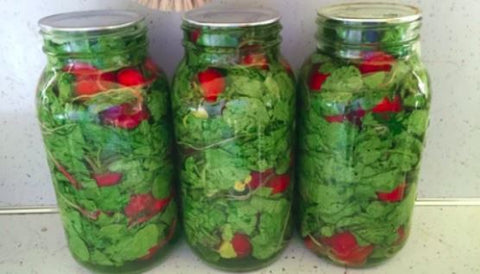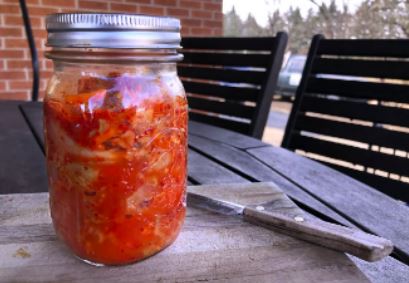
What is Live Fermentation?
Also known as “lacto-fermentation,” live fermentation is the natural process in which the starch/carbohydrates in veggies are converted into acid and alcohol by microorganisms already present in the veggies. In addition to excluding harmful bacteria, live fermentation allows for the proliferation of good lactobacillus bacteria (probiotics!), creating unique flavors and a ferment loaded with microbes that are great for your gut!
Why Should I Ferment?
- Fermented foods are delicious!
- It’s super easy to ferment foods!
- It’s totally safe to ferment foods! (see details below)
- Fermented foods are great for your gut health!
- Fermentation is a great way to preserve your fall harvest!
- Fermented foods last well! While live-fermented foods don’t last as long as canned foods, they can last for months when stored in the fridge.
Is Live Fermentation Safe?
Yes! Many modern people think fermentation may be dangerous because they have been warned about botulism in canned food. Still, botulism is only an issue with canning, an entirely different food preservation technique. In live fermentation, you encourage the growth of good bacteria and lactic acid, which prevents the growth of harmful bacteria. Canning uses extremely high temperatures with the goal of killing ALL bacteria, but if done improperly, it can potentially harbor dangerous botulism or other harmful bacteria.
The organisms in your ferment produce acid and alcohol to inhibit the growth of other bacteria. In addition, the microbes produce hydrogen peroxide, bacteriocins, and other antibacterial compounds to ward off other microorganisms. All you have to do is let them do their thing, and in time, you’ll be left with a delicious, nutritious, and safe bounty of fermented foods.
🥒 Live Fermentation vs. “Pickles”
“Modern” pickling was invented in 1940. It involves cooking veggies in vinegar at high temperatures for long periods, and this diminishes vitamins, including Vitamin C. But live pickling – also known as live fermentation – is a more traditional food preservation technique that has been used for centuries. It involves using naturally occurring bacteria (present in the vegetables) and brine (usually salt water) to preserve veggies.
Until 1940, fermentation was a primary means of food preservation. Examples include traditional sauerkraut and kimchi. Live pickling is an all-around better choice because of these factors:
- Live pickling enhances the vitamin content of the food
- Fermentation preserves and sometimes enhances the food's enzyme content, improving nutrient bioavailability in the body.
- Fermentation improves the digestibility of the food and even cooked foods that are consumed along with it!
Basic Pickling Recipe
Ingredients:
- One handful of any pickling vegetable (we like using snap beans, beets, carrots, cucumbers, collard & kale, radishes, and/or peppers!)
- One qt water
- 2 tbsp sea salt
- One clove garlic
Directions:
- Place a handful of pickling vegetable(s) in an empty quart jar and add one clove of garlic.
- Dissolve two tablespoons of sea salt in 1 quart of water to make brine.
- Pour brine over veggies until the jar is full—place jar on a tray or lipped plate to catch any spillover.
- To prevent veggies from being exposed to the air (which can cause mold to form on the surface), place some weighted surface, such as a plate with a weight on top, above the veggies so they remain submerged in the brine. You can also use a container with an airlock. Air is not harmful but may cause non-harmful mold to form on the surface, which can be skimmed off with a spoon.
- Cover the jar with a piece of cloth to keep flies out, and secure the cloth with a rubber band. Leave the jar at room temperature for 24 hours, then install the jar lid and place it in the fridge.
- Eat at any time depending on your tastes.

Kimchi (aka Baechu Kimchi) Recipe:
Want to get a little fancy with your ferment? Try this delicious Kimchi recipe adapted from “Wild Fermentation” by Sandor Katz.
Ingredients:
- Sea salt 1 pound/500 grams
- Chinese/Napa Cabbage
- A few radishes (optional)
- 1-2 carrots (optional)
- 1-2 onions and/or leeks and or a few scallions
- 3-4 cloves of garlic
- 3-4 hot red chilies (Erica loves sweet peppers instead of the traditional hot peppers - you can substitute if you like)
- Three tablespoons fresh grated ginger
Directions:
- Chop and soak the cabbage, radish, and carrot in a brine overnight. The brine should comprise about four cups of water and four tablespoons of sea salt.
- Prepare the paste (ginger, garlic, onion, hot/sweet peppers) - this can easily be done in a food processor.
- Strain the brine off of the cabbage.
- Mix the vegetables and the paste together.
- Stuff the vegetable-paste mixture into a jar and pour the brine over it to fill the jar. Ferment at room temperature for 1-3 days and then store in the refrigerator.
-- Recipe adapted from “Wild Fermentation: The Flavor, Nutrition, and Craft of Live-Culture Foods” by Sandor Ellix Katz, pg. 47 (2003).
Where Can I Learn More About Fermenting?
We highly recommend checking out any of Sandor Ellix Katz’s books on fermentation. In addition to veggie-based ferments, Katz covers in great depth a vast variety of other fermentation practices: dairy, meat, beer, and so much more! We especially love his book The Art of Fermentation.
